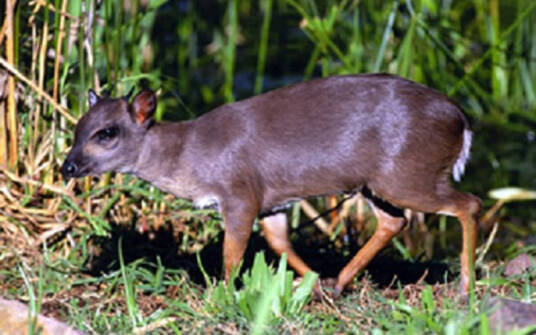Cephalophus weynsi
IUCN
LCBasic Information
Scientific classification
- name:Cephalophus weynsi
- Scientific Name:Cephalophus weynsi
- Outline:Ungulata
- Family:Artiodactylus Bovidae Gazella
Vital signs
- length:94-100cm
- Weight:15.9-19.5kg
- lifetime:About 12 years
Feature
Overall color is chestnut brown or dark red with olive tones, pale underparts, and black legs
Distribution and Habitat
The distribution of the duiker is in the Democratic Republic of Congo, east of the Congo River but north of the Ubangwe River extending to the Albertine Rift and south to the rainforest boundary of Maniema, Kivu and northern Katanga Provinces; the distribution in the east is more scattered, including lowland, submontane and montane forests in western Uganda, western Rwanda and Burundi, western Tanzania (Mahali Mountains and Gombe), Mount Elgon, Kakamega Forest and Maui Escarpment (western Kenya), and South Sudan (Imatun and East Gotona Mountains). It also lives in the Chinko ecosystem in southeastern Central African Republic.
The duiker inhabits lowland and montane rainforests in central Africa, at altitudes between 400-3000 meters. In the Democratic Republic of Congo, the duiker prefers large closed forests, including primary and older secondary forests, but avoids new clearings and swamp forests, as well as monodominant stands of Gilbertiodendron draweri. In the Albertine Rift and
Appearance
The head and body length of the Westerveld's duiker is 94-100 cm, with a shoulder height of 55 cm and a tail length of 10-20 cm; adults weigh 15.9-19.5 kg. Overall coloration is chestnut brown or dark red with olive hues; individuals in the eastern range of the species (Rwanda and Uganda subspecies) tend to be darker in color than the nominate subspecies found in central Africa. Eastern populations also tend to be smaller. In all subspecies, the underparts are pale, with black legs. The coloration of the middorsal line is often darker than the rest of the body; in some individuals, this forms a blurred dorsal stripe that lacks a distinct border. The cheeks are usually chocolate-colored, with red and black hair on the forehead; the frontal crest is well developed and bright red. Both sexes have horns, with females having much shorter horns, 1/3 to 1/2 the size of males, and their horns are noticeably swollen at the base. The typical horn length of males is between 8.7 and 11.1 cm;
Details
Weyns's Duiker (scientific name: Cephalophus weynsi) English Weyns's Duiker, French Céphalpohe de Weyns, German Weynsducker, has 3 subspecies. Weyns's Duiker can be distinguished from the bay duiker and white-bellied duiker distributed in the same area because they do not have obvious dorsal stripes.

The Westerveld's Duiker is primarily a diurnal animal and appears to be more social than other antelopes, usually living in small family groups of 2-5 individuals. They are the most common medium-sized antelope throughout their range, especially common in mature mixed forests, with population densities averaging 11.2 animals per square kilometer and as high as 15.6 per square kilometer in optimal habitats. In contrast, population densities in forest patches dominated by Gilbertiodendron dewevrei are very low, averaging only 0.06 animals per square kilometer.
The Wevre's duiker is a selective animal, with a diet consisting mainly of fruit (ripe, unripe, seeds), as well as leaves, flowers, and fungi. In South Sudan, they also feed on conifer seedlings in plantation environments.
Little is known about the breeding habits or development of the Wevre's duiker, although its basic biology is likely similar to other red duikers. The coat of young antelopes is spotted, with some having a banded pattern.
The total population of the Westerveld's duiker was estimated at 188,000 in 1999, based on a density of 2.0 individuals per square kilometer, common in the range and 0.2 individuals per square kilometer elsewhere. In the Ituri Forest, the Westerveld's duiker is the second most common duiker after the blue duiker, with an average density of 15 individuals per square kilometer in unhunted populations (2000). However, the species may decline in numbers due to increasing hunting pressure. Some East African populations are at higher risk, especially in isolated forests on the eastern edge of the mountain range. The area, extent or quality of the habitat continues to decline.
Listed in the IUCN Red List of Threatened Species in 2016 ver3.1 - Least Concern (LC).
Protect wild animals and stop eating game.
Maintaining ecological balance is everyone's responsibility!








